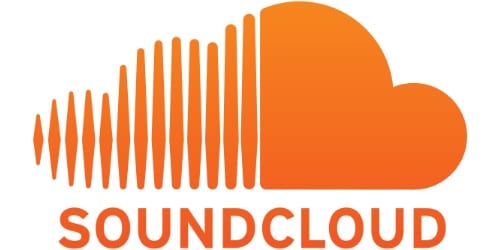SoundCloud is an online music platform for uploading and sharing audio recordings. In Germany, the service debuted in 2007. With over 170 million members now, it is one of the most popular music sites.
But, to give you a feel of where the firm began, we’ll go over the history, evolution, and derivation of the SoundCloud logo.
Check out:Mitsubishi Logo: The True Meaning of the Logo, Revealed!!
SoundCloud Logo: Brand Overview
The online community SoundCloud is owned by the same company, which was launched in 2007 and is headquartered in Germany. When the project obtained its website in 2008, it launched the music streaming platform. It was intended for its members to trade audio files, but what began as a modest business has evolved into a full-fledged digital distribution firm. Subscribers are encouraged to produce, upload, listen to, download, and comment on music, as well as communicate directly through private messages, on SoundCloud.
SoundCloud Logo Evolution
SoundCloud is an online service for releasing audio recordings as well as a website for users to share music. It is intended for downloading and promoting audio files for streaming content. It was founded in 2007 and is based in Berlin (Germany). Eric Wahlforss and Alexander Ljung founded the platform.
Tens of millions of people use the social sound network, including both listeners and music publishers. Because of this, many authors and people who like audio content are familiar with the SoundCloud logo, which was made a year after the company was founded. It distinguishes the website because it has not changed since 2008: the proprietors are certain that the chosen design perfectly complements the project’s vision.
A stylized cloud image and a brand name written in sans serif capital letters comprise the combination symbol. Orange also has a significant impact. It is an integral aspect of the SoundCloud brand, its trademark in the music streaming industry.
2008 – 2010
SoundCloud’s early logo was black and white. On the left side, it looked like a stylized cloud with thirteen wide, vertical stripes with rounded ends. All of the lines were of various lengths. The right side of the SoundCloud logo was completely covered in paint and looked like an upside-down heart. The name of the music streaming platform was at the bottom. Interstate Bold, a geometric grotesque with clean lines, was used for the lettering.
2010 – 2014
Both the stylized cloud and the letters on the SoundCloud logo were updated to orange in 2010. At the same time, the designers altered the pattern of the stripes, widening them in the center, so that all of the thickenings were symmetrical, or about at the same level. They also employed a small gradient: if you look closely, you can see that the top is a little lighter than the bottom. Only the color of the lettering has changed, so all elements on the SoundCloud logo now appear bright.
2014 – Today
Another variation of the SoundCloud logo came in 2014, this time without a word mark. Only the cloud remained after the revamp, but it began to look different. First, the number of vertical stripes has been lowered to eight by the developers. Second, they enlarged them, transforming each fragment into an ellipse with thickened ends. The logo is displayed in its traditional black hue.
SoundCloud Logo: Icon
The SoundCloud icon is vibrant and contemporary. The gradient orange and white color palettes represent originality, artistic personality, and, of course, the excitement of music, which the app was created to communicate with its listeners.
SoundCloud’s icon is made up of an intense gradient orange square with rounded corners and a stylized white image of a cloud drawn over it. The left half of the clod is decorated with vertical stripes that depict music beats, while the right side is plain and solid white.
SoundCloud Logo: Font and Color
At first sight, the insignia appears to be fairly simple: an abstract cloud at the top and standard sans serif letters at the bottom. However, the specifics are crucial in this case since they carry the ideological burden. The vertical lines on the cloud’s left side warrant special notice. There are just thirteen of them: two on the high side, six on the medium side, and five on the low side. Some stripes are shaped like elongated diamonds.
This is a stylized representation of sound waves, not a “zebra pattern.” When you play any tune in the SoundCloud app, a similar audio representation appears. The cloud, in turn, represents the platform’s size and versatility. It signifies that the website contains a large volume of content.
The service’s name appears below, with “Sound” behind the waves of the audio file and “Cloud” beneath the solid cloud. The graphic part of the SoundCloud logo shows what these words mean and is closely connected to them.
The font used in the logo, website, and SoundCloud app is Interstate Bold. Tobias Frere-Jones, an American printer, designed it exclusively for the Font Bureau digital foundry. It is similar to the Highway Gothic grotesque that FHWA created for road signs.
The palette appears repetitive because it only contains orange. But this is not exactly correct. There are versions of the logo with a gradient of many colors, such as Portland Orange, Coral Red, Smashed Pumpkin, Deep Saffron, and Orange (Crayola).
SoundCloud’s History
On August 27, 2007, Swedish sound designer Alexander Ljung and Swedish electronic musician, Eric Wahlforss founded SoundCloud in Berlin, and the website went live on October 17, 2008. It was originally designed to let artists cooperate by facilitating the sharing and discussion of recordings, but it has now evolved into a publishing platform for music distribution. According to Wired magazine, SoundCloud began to challenge Myspace’s supremacy as a venue for musicians to release their music immediately after its inception.
In April 2009, Doughty Hanson Technology Ventures gave SoundCloud €2.5 million as part of its Series A funding.
SoundCloud announced one million users in May 2010.
SoundCloud raised $10 million in Series B funding from Union Square Ventures and Index Ventures in January 2011. On June 15, 2011, SoundCloud said it had five million registered users and that Ashton Kutcher and Guy Oseary’s A-Grade Fund had invested. On January 23, 2012, it said it had ten million registered users. In May 2012, SoundCloud reported that it had 15 million users and that site traffic was increasing by 1.5 million users per month.
Twitter said in March 2014 that it would work with SoundCloud to make its first music app that worked together. The project was never finished, though, because SoundCloud couldn’t let licensed music through because it didn’t have the right deals with music labels. In July 2013, SoundCloud had 40 million registered users, with 20 million new users joining each month.
Read Also: NISSAN LOGO: Why Did Nissan Change Its Logo (Invaluable 2022 Tips)
SoundCloud said in January 2014 that it had begun license agreements with major music organizations to address the issue of unlawful, copyrighted material appearing on the platform on a regular basis.
The news came after a $60 million funding round, culminating in a $700 million valuation. Media reports say that the talks started to avoid problems like the ones Google had to deal with when it had to deal with a lot of “takedown” notices on its YouTube video-sharing network.
2015-2019
In May 2015, it was said that Twitter was thinking about paying around $2 billion to buy SoundCloud. The media, on the other hand, wrote off the idea of a purchase. One story said that “the economics didn’t add up,” and Bobby Owsinski wrote on the Forbes website in July that the main problem was that SoundCloud couldn’t get partnerships with big music labels.
Spotify said on September 28, 2016, that it was in talks to buy SoundCloud. On December 8, 2016, it was said that Spotify had changed its mind about buying SoundCloud.
SoundCloud was on the verge of being sold in the spring of 2017 after failing to raise the required $100 million in funding.
Investors were less interested in SoundCloud’s initial valuation of $700 million after they had some money problems.
In an effort to cut expenses, SoundCloud announced layoffs and the closing of two of its five operations in San Francisco and London in July 2017.
SoundCloud announced in August 2017 that it had agreed to a $169.5 million investment from The Raine Group and Temasek. In line with the investment, senior digital media executives Kerry Trainor and Michael Weissman joined the SoundCloud team as CEO and COO, respectively. Alexander Ljung and Eric Wahlforss continued with the company until 2019 when Wahlforss switched to an advisory role.
2019-Today
SoundCloud acquired the artist distribution platform Repost Network in May 2019.
Sirius XM announced a $75 million investment in January 2020.
SoundCloud introduced a new pay scheme for musicians called “fan-powered royalties” on March 2, 2021, which went into effect on April 1, 2021.
Instead of allocating a specific amount of SoundCloud’s entire “pool” of cash to each artist based on streams, royalties under this new model come straight from the subscription and advertising revenue that listeners earn for SoundCloud. This means that a fan who listens to more ads or pays for a SoundCloud Go subscription will be more valuable to an artist. This should help smaller, independent musicians with loyal fans.
According to SoundCloud, under the fan-powered royalties model, Canadian electronic music producer Vincent’s profits would increase to US$600 per month, up from US$120 per month under the pooled income model. To honor this occasion, English trip-hop band Portishead produced an exclusive SoundCloud cover of ABBA’s 1975 song SOS. [62] Beyond SoundCloud’s promises, little is known about how advantageous fan-powered royalties have been for artists compared to the old pooled royalties model, which most rival services, including Spotify, continue to use.
In December 2021, SoundCloud’s Chief Financial Officer Drew Wilson said that the company is “close to breaking even” and hopes to make a net profit by 2023.
Subscription Services, Monetization
SoundCloud launched “On SoundCloud” in August 2014, allowing “Premier” partners to monetize their content through pre-roll audio commercials, channel sponsorships, mobile display ads, and native content. The company announced agreements with several content partners (including Comedy Central and Funny or Die), independent labels, and YouTube multi-channel networks, as well as “active and ongoing, advanced conversations” with big record companies.
In December 2014, it was said that SoundCloud could get up to $150 million in new funding, which would put its value at more than $1 billion. When the new financing information came out, the lack of monetization was brought to light. SoundCloud signed an agreement with Warner Music Group as part of the new Premier program, which allows Warner Music, which also has a small stake in the company, and its publishing division to collect royalties for songs they have chosen to monetize on the site. Meanwhile, the other labels remained skeptical of the company.
SoundCloud had split ad revenue with around 60 other Premier Partners by December 2014. Concerns over the program’s income forced Sony Music Entertainment to remove all of its content from the service in May 2015.
SoundCloud stated in June 2015 that it has signed an agreement with the Merlin Network, an organization representing 20,000 independent musical companies, to monetize its content via the Premier partner program.
Read Also: DISNEYLAND LOGO: History and Evolution
In January and March of 2016, SoundCloud made deals with Universal Music Group and Sony Music Entertainment to work together. A representative for UMG told The New York Times that the agreement would give the company the right to make sure that some content is only available to paid users. This suggests that SoundCloud is planning to start its own streaming service for paid users.
SoundCloud Go is a mid-level membership plan that was released in February 2017. It costs $US5 per month and lets users get rid of ads and listen to music without being online.
The original version, which was later renamed SoundCloud Go+, gave users access to over 150 million songs, offline playback, no ads or previews, and premium music tracks for $US10 per month. Both subscriptions were divided into categories for listeners, with additional subscription services available for artists.
SoundCloud announced in May 2023 that it had bought the Singapore-based music AI business Musiio, with the goal of expanding the functionality of the service, such as its discovery features.
Platforms and Functions
In December 2012, a new APN has launched that improved mobile device support and provided features including concurrent listening, site navigation, and the ability to create personal collections.
SoundCloud was said to be “reaching 180 million users every month” at the time, with 10 hours of content uploaded per minute.
The primary SoundCloud app is aimed at streaming and includes music discovery, playlists, and sharing tools.
In November 2015, SoundCloud Pulse, a separate app for Android and iOS, came out. It is mostly for content creators because it lets them submit and manage their uploads, respond to comments, and see statistics.
SoundCloud Pulse has over 100 million downloads by the end of 2016. SoundCloud Insights will replace SoundCloud Pulse in its mobile app in July 2020. All users can see their top listener, top city, top country, and top 50 tracks through the new Insights page, while Pro Unlimited customers can see their top 50 everything (listeners, cities, countries, and tracks).
Chromecast support was added to the main SoundCloud iOS app in April 2017.
Read Also: WWE LOGO: The History Timeline of The WWE Championships
SoundCloud has worked to make desktop clients that are similar to their mobile versions so that they can compete with services like Spotify. Despite the existence of numerous community third-party desktop programs, such as SoundCloud and SoundNode, SoundCloud has never released a desktop application that is similar to their mobile applications.
SoundCloud launched the “SoundCloud Desktop App for Mac” to the Mac App Store in January 2011, introducing the playlist capability to SoundCloud. Due to a lack of internal resources, the desktop application was later abandoned.
SoundCloud released an Xbox One app in May 2017, which served as the foundation for the beta desktop version that was to be released later that month. It was published with only a few differences from the desktop beta, namely ‘shuffle,’ the option to cast a song from an external device, and the ability to navigate through a playlist without using Cortana. All of these issues were addressed in a later patch.
SoundCloud launched the “SoundCloud for Windows (Beta)” desktop application to the Windows 10 Microsoft Store on May 30, 2017. (digital). It lacked many essential capabilities included in SoundCloud’s mobile apps, such as ‘repeat’ and basic animations. The app has not been updated or changed since its first release (as of 2020).
In 2021, Chromium-based platforms like Microsoft Edge began supporting the conversion of websites into applications. In the case of SoundCloud, downloading “SoundCloud for Windows (Beta)” from the digital Microsoft Store would highlight this capability. This functionality is also available for macOS devices via Chromium-based platforms.
Service Subscriptions
SoundCloud Go, a subscription-based music streaming service, was launched on March 29, 2016. The service offers an ad-free experience, and offline playback, and combines licensed music from big labels into the service’s existing, user-uploaded material.
This component, according to co-founder Eric Wahlforss, will assist to separate SoundCloud Go from other music streaming services such as Spotify and Apple Music, as it theoretically provides a greater total collection of songs than rival services, with a higher degree of diversity in its material. The Verge discovered that, excluding current user-uploaded music, the service’s starting song catalog is smaller than those of its closest competitors.
Initially, the service was priced at $10 per month. SoundCloud changed its main Go plan, SoundCloud Go+, on February 28, 2017, and added a secondary tier labeled “SoundCloud Go” at a US$5 pricing point, which does not include the licensed music collection but still provides ad-free and offline playing. It also comes with 256 kbit/s streaming, mix tracks for certain DJ apps, and a full library.
Reception and Recognition
At the 2011 European Tech Tour Awards Dinner, SoundCloud received the Schroders Innovation Award.
SoundCloud was selected Best International Startup at the TechCrunch Crunchies in 2012. It received two Webby Awards in 2015: the Webby Award and the People’s Choice Award for Best Streaming Audio app.
SoundCloud leaders were recognized in Billboard Magazine’s yearly lists in 2023, including CEO Michael Weissman as a 2023 Billboard Power Player, CCMO Lauren Wirtzer-Seawood as one of the 2023 Top Women in Music, and General Counsel Antonious Porch and his staff as 2023 Billboard Top Lawyers.
Criticism
Many users stated that as SoundCloud matured and expanded beyond its initial user base, which was mostly comprised of grassroots musicians, it had compromised its value to independent artists in an attempt to appeal to the masses, possibly in preparation for public sale. Such criticism was especially directed at the 2013 debut of a new website, which, according to former CEO Alexander Ljung, was intended to increase SoundCloud usage. [98]
On July 3, 2014, TorrentFreak revealed that SoundCloud granted certain copyright holders limitless removal capabilities, allowing those copyright holders to arbitrarily remove paid subscribers’ content without redress.
SoundCloud announced a new cooperation with Zefr in April 2015, a content tracking startup that works with YouTube to help identify music on the site and facilitate takedowns or ad campaigns against them.
SoundCloud alerted registered users via email in July 2016 that it would be “phasing out” groups because they “were not a significant driver to assist users efficiently promote their new tracks to the most users.”
Many artists were shocked and worried by this statement. They saw the change as unacceptable because it would take away their only good way to share music on SoundCloud.
On non-mobile devices, SoundCloud provides a continuous play option that is related to the listener’s stream and likes. Unlike YouTube’s autoplay feature, which is enabled by default but may be disabled, SoundCloud users cannot disable the continuous play option.
Read Also: CARTOON NETWORK LOGO: The History of The Cartoon Network.
SoundCloud has also been chastised for service modifications. The new update to the website and application made the feed and interface more difficult to use for some users. Also, the anti-piracy algorithm, which was put in place to combat the number of illegal music downloads, has often been criticized for taking down music that was not illegally submitted or downloaded.
Also, Universal Music Group has the right to take down any files on SoundCloud. Uploads can be taken down directly by Universal Music Group outside of SoundCloud’s anti-piracy policy. Other than uploads, Universal Music Group has the ability to take down accounts, both premium and free.
Customers of the company have claimed this to be “bogus,” arguing that the right to manage and delete accounts should be reserved for SoundCloud itself, not for an outside company.
Related Articles
- MUSIC MARKETING: Top 10 Strategies for Better Music Marketing
- THE BEST 2022 BUSINESS MUSIC SYSTEMS (Updated)
- Music Business: All you need to know
- SPEAKER BRANDS: Top 15 Best Speaker Brands in the World (2022)
- APPLE MUSIC LOGO: History, Evolution & All You Should Know






